Why the ‘robo-trap’?
Longtime trap-neuter-return advocate tests out remote trapping technology
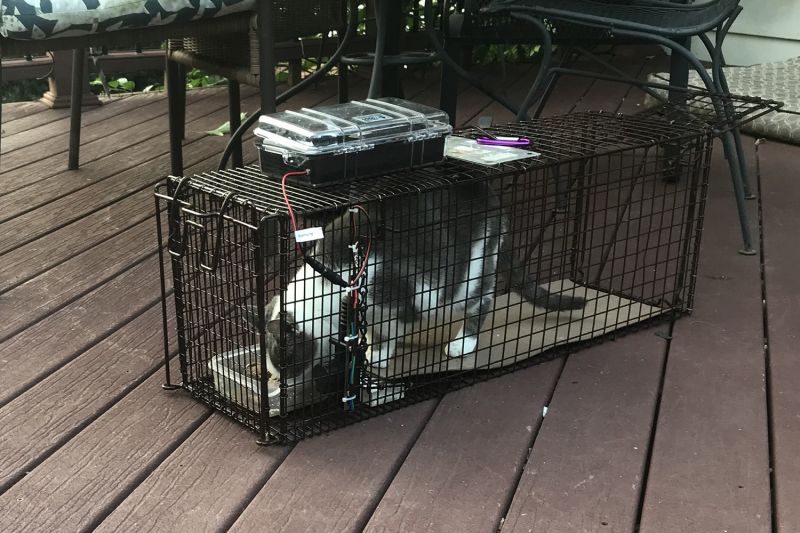
It’s a Saturday morning, and I’m on kitty stakeout, parked outside a mobile home waiting for a cat to show up and follow the smell of tuna to the drop trap I set up hours ago.
As the minutes tick by, community cats, all sporting left ear-tips, dart in and out of holes in the metal skirting beneath the trailer home. But so far, the jowly tabby who’s eluded my traps on previous weekends, the one I’ve named John Wayne for the way he swaggers around the neighborhood, isn’t among them.
This is my least favorite part of trap-neuter-return: when most of the cats in a location have been fixed and I’m going after the few holdouts. It’s frustrating and often boring, and there’s no guarantee I’ll have anything to show for my efforts.
But on this day, I’ve doubled my chances. Half a mile away is another group of cats, also in my docket of nearly completed cases. They’re fed by an elderly couple I’ll call the Smiths.
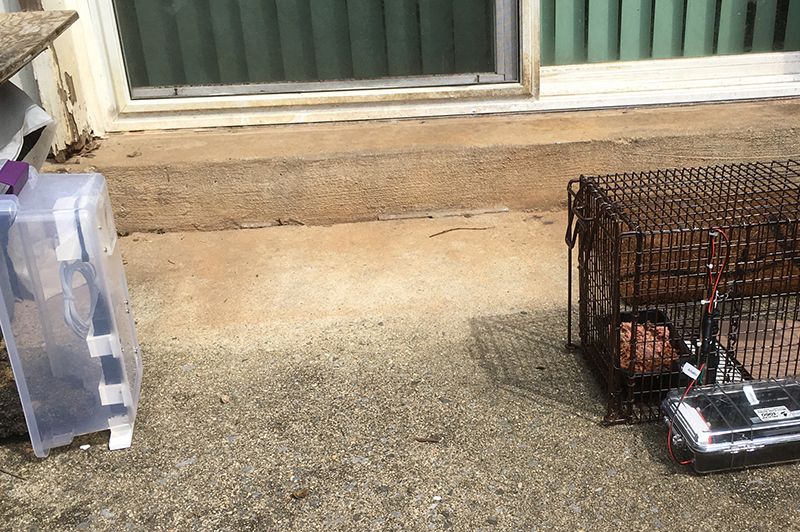
First thing this morning, I set up my new robo-trap system on the Smiths’ back patio in hopes of nabbing Spotty, a white-with-black-splotches female and the source of several previous litters. While I wait for John Wayne at the mobile home park, I’m also monitoring the activity on the Smiths’ patio, livestreamed from a Wyze camera onto my iPhone. Motion alerts ding on my phone as previously TNR’d cats enter the trap, eat their fill and then back out of the trap.
If all works according to plan, Spotty will eventually appear and venture into the trap, and I’ll push a button on my phone to make the trap door fall.
And that’s exactly how it unfolds. John Wayne never shows up that day (I manage to trap him a few weeks later), but during my first outing with the robo-trap system, I nab Spotty and a lookalike I didn’t even know about.
When the lookalike arrives on the scene, it’s late afternoon and I’m five miles away, having raced home for a bathroom break (a necessity in the COVID era, when many restaurant restrooms are closed to the public). I’m getting back into my car when the motion alert sounds. There in my driveway, I open the phone app that controls the trap trigger and press the button. Then I call Mrs. Smith, who covers the trap while I drive back to her home.
Thanks to my new robo-trap, designed by a TNR volunteer nearly 3,000 miles away, the Smiths’ cat clowder reaches 100% sterilization status that weekend.
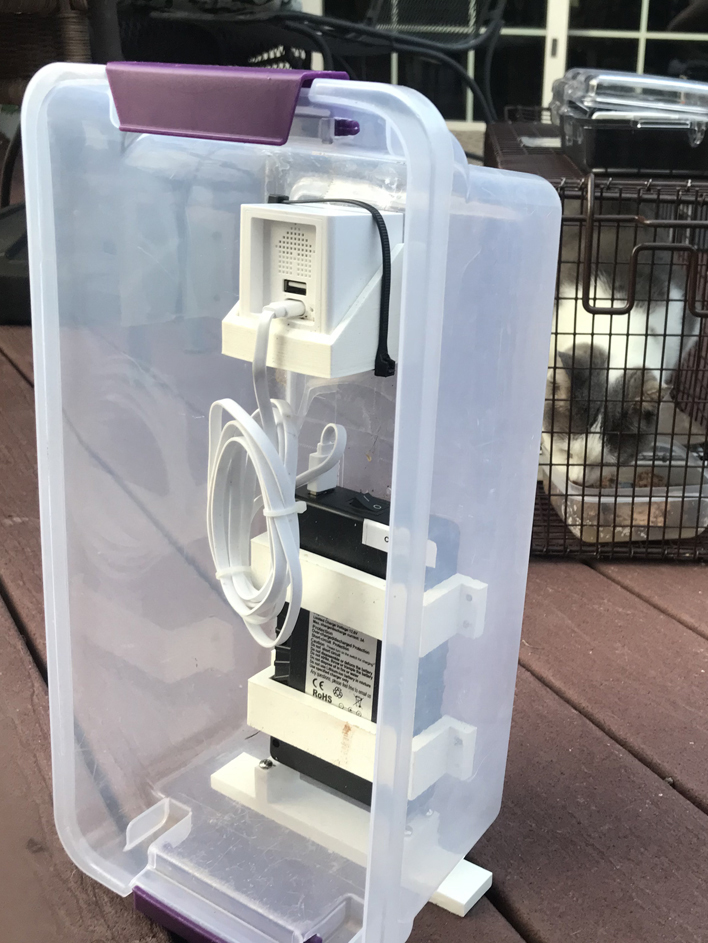
I learned about the robo-trap—which combines a portable hot spot, livestreaming camera, and a car door actuator attached to a Tru Catch box trap to enable remote monitoring and selective trapping of unsocialized cats—early this year on Community Cats United’s TNR Facebook group. And even though I was the last of my friends to purchase a cell phone, even though I still struggle with my “smart” TV, I immediately decided I needed this.
I’ve since robo-trapped a few dozen cats, most of them holdouts who threatened to undo all my hard work stabilizing feline numbers in a particular location. That’s been enough to make me a fan.
That said, the robo-trap doesn’t work miracles: You still need the target cat to show up and enter the trap, and since cats have their own agendas, that doesn’t always happen. Still, over the past eight months, this technology has become a valuable part of my TNR toolkit. Here’s what I’ve learned.
The pros
Allows for double duty. The robo-trap essentially allows me to be in two places at the same time, something that became increasingly necessary after COVID hit and the private practice veterinarians in my area no longer had the bandwidth for occasional weekday TNR surgeries. Fewer spay/neuter options meant fewer days I could trap, and I was increasingly faced with the decision of whether to spend my limited time trying to catch the last cat at Location A or to start tackling Location B.
Works great for backyards. While there are situations where I need to be physically on the scene watching my traps, for the safety of the animals and my equipment, most times I’m trapping in people’s backyards, where it’s safe to monitor traps via a camera. Often, the caretaker is home and we work in tandem, with the caretaker immediately covering the trap after we’ve caught the target cat. Otherwise, I secure a cover to the trap before I set it. I’m never more than 15 minutes away, but this way the trap is covered, reducing the cat’s stress, during the time it takes me to return to the location.
Monitors more than cats. Sometimes, as with the Smith case, I need to watch more than the cats. Mr. Smith has a shaky memory and an inability to withhold cat food. I spent two weekends in his backyard with a drop trap, only to find that if I left my post for 10 seconds to retrieve something from my car, he would take the opportunity to feed the cats. The day I put the robo-trap on his patio, I twice spied him putting out bowls of kibble and called Mrs. Smith, who immediately removed them. I’ve also used the speaker function on the camera to give guidance to caretakers (and a few times to shout “go away” and watch a startled raccoon back away from the trap).
Camera alone has several uses. When selective trapping isn’t needed, the livestreaming camera by itself can be useful. A few months ago, I got a frantic call from a woman whose shy pet cat Jujube escaped outside a vet clinic and had been hunkered down in a storm drain for four days. The grate over the drain was welded shut; the only option was to set a trap in a connected tunnel that wasn’t visible from the street. After borrowing a tool to lift the heavy manhole cover, I climbed down the tunnel, set a regular trap, and used the camera and hot spot to monitor when Jujube got caught (at 3 a.m., as it turned out). I’ve also used the camera and hot spot when I’m on-site at a trapping location but don’t have a good vantage point for watching all the traps I’ve set, it’s too hot or cold to sit outside, or I need to stay out of sight of the drop trap to avoid spooking the cats.
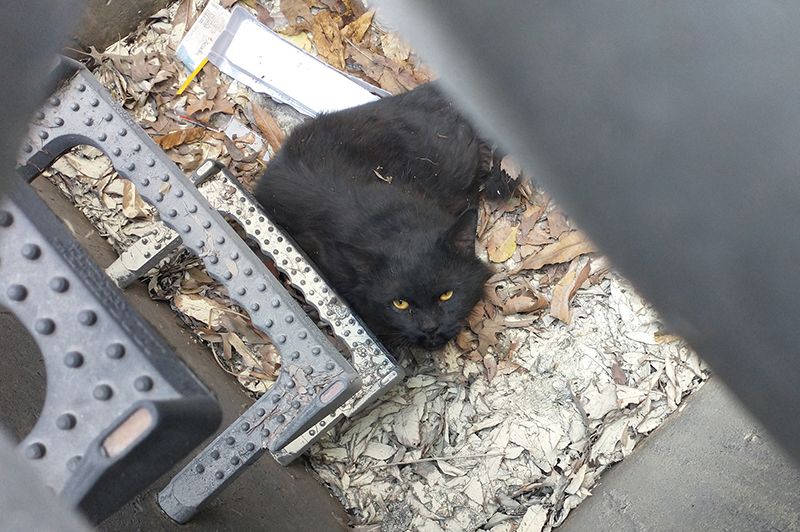
The cons
Requires cellular data. As my tech-savvy friend Steve explains it, my robo-trap camera and release switch use Wi-Fi to connect to the portable hot spot, which uses cellular data to connect to the internet. Phew! While I live in a county where the cell phone coverage for my hot spot is typically strong, I’ve discovered a few dead zones where the cellular data is too slow to support the camera feed or fails to connect at all. If you’re in a rural area where cell coverage is spotty, the robo-trap (and the monthly cost for cellular data) may be more frustration than it’s worth.
Requires constant vigilance. Remote trapping requires multitasking. While I once listened to podcasts or worked on my computer while waiting for a particular cat at Location A to appear and venture under my drop trap, now I’m checking motion alerts on my phone from Location B. A few times, the holdout cat at Location A has shown up at the same time the target cat at Location B appeared on my camera feed, forcing me to act fast to get both cats. Plus, as designed, jumbo-size cats or other forces can accidentally close the door on the remote trap and capture the wrong animal, which means you always need to be monitoring the trap while it’s set. (If it’s late at night and I’ve given up waiting for my target cat to appear, I push the button on my phone and watch the trap door fall, safe in the knowledge that no animal will be accidentally caught while I sleep).
Costs a pretty penny. I spent $330 for the camera, hot spot, actuator kits and assorted bits and pieces to outfit two traps. The hot spot costs an additional $40 a month for 30GB of data (I use about 2GB of data for every 10 hours I use the system). This doesn’t include the costs of the traps since I repurposed two laggy traps that weren’t working well for regular trapping. My robo-trap system wasn’t cheap, but for me, the time and gas savings, and the increased ability to nab elusive cats, make it worth the expense.

Tips and tricks
Find a tech-savvy friend. While the robo-trap’s inventor, Deb Skilton Webster with South County Cats, provides detailed building instructions and advice on Community Cats United’s Facebook group, you can’t buy a ready-made robo-trap. You must build it yourself, or in my case, find a friend who has the skill and knowledge to do it. My fellow rescue volunteer Steve says it took him about five hours to put together.
Give it some time. If you’re like me, using the equipment won’t come naturally at first. And since the last thing I want to do on busy trapping days is troubleshoot equipment in the field or try to remember which cord goes where, I typed up step-by-step instructions, practiced at home and learned how to use the apps that control the camera and the actuator. (On the plus side, I’ve worked with a handful of tech-savvy caretakers who were able to take my detailed instructions and share monitoring duties or operate the robo-trap themselves.)
Place the camera with care. I point the camera facing the back of the traps, which allows me to watch each cat as they’re eating and check for an ear-tip. If you don’t want your phone constantly dinging with motion alerts, make sure the camera isn’t facing a busy street or other moving objects, something I learned after setting my robo-trap near porch windchimes on a day with a light breeze.
Use ample bait. In one large group, I watched with mounting frustration as ear-tipped cats entered the trap one by one while my target cat waited at the back of the queue. Fortunately, I’d heeded advice to bait the trap with a lot of food, and there was still some left by the time target kitty got a turn. I found a clear plastic food storage container that holds about a dozen 5.5-ounce cans of cat food or tuna and fits perfectly in the space between the Tru Catch trip plate and the back door (though they don’t hold as much, the 4-by-7-inch plastic containers my grocery store sells mushrooms in also work). Once I catch a target cat, I transfer them to a regular trap in the safe confines of my garage, which protects the actuator device and makes for easier trap cleaning and disinfection later.
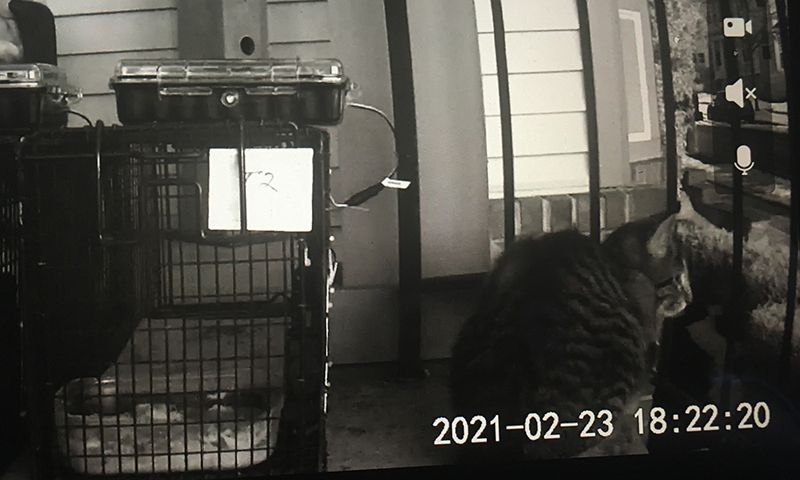
Modify at night. Low-light conditions can make ear-tips difficult to detect on a small phone screen. I’ve found that a standing flashlight with a head that can be angled is essential when outdoor lighting is minimal; different camera settings work better at night; and watching the camera feed on a larger screen, such as an iPad, also helps.
All in all, I’ve had enough success with my robo-trap system to be an enthusiast. I also know it isn’t for everyone: It’s more equipment to lug around and maintain, it doesn’t work everywhere and it doesn’t solve every TNR challenge. But as more people apply their ingenuity and tech skills to the cause, I hope to see more innovations like this.
I suspect that livestreaming cameras and traps controlled with phone apps will become increasingly popular in TNR work, and some day the major trap manufacturers will incorporate this technology in their designs. And even though I’ve been a late adopter of every other smart device, I’ll be first in line for the smart trap.







